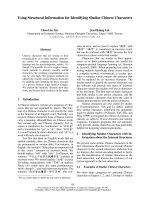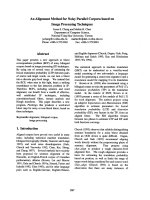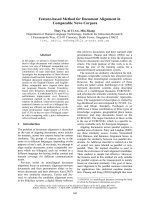Báo cáo toán học: "Using Boundary-Operator Method for Approximate Solution of a Boundary Value Problem (BVP) for Triharmonic Equation" ppsx
Bạn đang xem bản rút gọn của tài liệu. Xem và tải ngay bản đầy đủ của tài liệu tại đây (117.86 KB, 9 trang )
Vietnam Journal of Mathematics 33:1 (2005) 9–17
Using Boundary-Operator Method
for Approximate Solution of a Boundary Value
Problem (BVP) for Triharmonic Equation
*
Dang Quang A
Hanoi Institute of Inform. Technology, 18 Hoang Quoc Viet Road, Hanoi, Vietnam
Received April 25, 2003
Revised November 23, 2004
Abstract In this paper we propose and study an iterative method for solving a BVP
for a triharmonic type equation. It is based on using a boundary-domain operator
defined on pairs of boundary and domain functions in combination with parametric
extrapolation technique. This method iteratively reduces the BVP for sixth order
equation to a sequence of BVPs for Poisson equation.
1. Introduction
In earlier papers we developed the boundary operator method for construct-
ing and investigating the convergence of a domain decomposition method for a
BVP for second order elliptic equation with discontinuous coefficients [1], and
an iterative method for the Dirichlet problem for the biharmonic type equation
Δ
2
u − aΔu + bu = f when a
2
− 4b ≥ 0 [2]. In the case if the latter condition
is not satisfied, for example for the equation Δ
2
u + bu = f describing the bend
of a plate on elastic foundation, the boundary operator method does not work.
Therefore, for treating this case in [3] we have introduced boundary-domain
operator defined on pairs of domain functions and boundary functions. With
the help of this operator the BVP for biharmonic type equation is reduced to a
∗
This work was supported in part by the National Basic Research Program in Natural Science
Vietnam.
10 Dang Quang A
sequence of BVPs for Poisson equation.
In this paper the boundary-domain operator method is used for constructing
and studying an iterative method for the following BVP for triharmonic equation
Δ
3
u − au = f(x),x∈ Ω,
u|
Γ
=0, Δu|
Γ
=0, (1)
∂u
∂ν
Γ
=0,
where Δ is the Laplace operator, Ω is a bounded domain in R
n
(n ≥ 2), Γis
the sufficiently smooth boundary of Ω, ν is the outward normal to Γ and a is a
positive number. The solvability and smoothness of the solution of problem (1)
follows from the general theory of elliptic problems (see [5]), namely, if f ∈ H
s
(Ω)
then there exists a unique solution u ∈ H
s+6
(Ω). Here, as usual, H
s
(Ω) is
Sobolev space.
2. Reduction of BVP to Boundary-Domain Operator Equation
We set
Δu = v, Δv = w
and
ϕ = au (2)
and denote by w
0
the trace of w on Γ , i.e. w
0
= w|
Γ
.Thenfrom(1)wecome
to the sequence of problems
Δw = f + ϕ, x ∈ Ω,w|
Γ
= w
0
,
Δv = w, x ∈ Ω,v|
Γ
=0, (3)
Δu = v, x ∈ Ω,u|
Γ
=0,
where the functions ϕ and w
0
are temporarily undefined. The solution u from
the above problems should satisfy the last condition in (1) and the relation (2),
i.e.
au = ϕ,
∂u
∂ν
Γ
=0. (4)
Now, we introduce the operator B defined on pairs of boundary functions
w
0
and domain functions ϕ
z =
w
0
ϕ
by the formula
Bz =
−a
∂u
∂ν
ϕ − au
, (5)
Boundary-Operator Method for Approximate Solution of Boundary Value Problem 11
where u is found from the sequence of problems
Δw = ϕ, x ∈ Ω,w|
Γ
= w
0
,
Δv = w, x ∈ Ω,v|
Γ
=0, (6)
Δu = v, x ∈ Ω,u|
Γ
=0.
Notice that the operator B primarily defined on smooth functions is extended
by continuity on the whole space H = L
2
(Γ) × L
2
(Ω). Its properties will be
investigated later.
Theorem 1.
a) Suppose that u is the solution of the original Problem (1) and
w
0
=Δ
2
u|
Γ
,ϕ= au. (7)
Then the pair of functions z =(w
0
,ϕ)
T
,whereT denotes transpose, satisfies
the operator equation
Bz = F, (8)
where
F =
a
∂u
2
∂ν
au
2
, (9)
u
2
being determined from the problems
Δw
2
= f, x ∈ Ω,w
2
|
Γ
=0,
Δv
2
= w
2
,x∈ Ω,v
2
|
Γ
=0, (10)
Δu
2
= v
2
,x∈ Ω,u
2
|
Γ
=0.
b) Conversely, each pair of functions z =(w
0
,ϕ)
T
, which is the solution of
the equation (8) - (10) uniquely defines a function u which is the solution of the
Problem (1) such that the relation (7) is valid.
Proof. The Part a) of the theorem is easy proved if after reducing the Problem
(1) to the sequence of the problems (3) we represent
(u, v, w)=(u
1
,v
1
,w
1
)+(u
2
,v
2
,w
2
),
where u
1
,v
1
,w
1
satisfy the problems (6) and u
2
,v
2
,w
2
satisfy (10) and take into
account the definition of the operator B.
For proving Part b) let u
1
be the solution of (6). Then by the definition of
B we have
Bz =
−a
∂u
1
∂ν
ϕ − au
1
.
Take into account (9), from (8) we obtain
∂(u
1
+ u
2
)
∂ν
=0,ϕ− a(u
1
+ u
2
)=0.
12 Dang Quang A
Now, it is easy to verify that the function u = u
1
+ u
2
is the solution of Problem
(1) and there holds the relation (7).
The theorem is proved.
Now, let us study the properties of B in the space H with the scalar product
(z, ¯z)=(w
0
, ¯w
0
)
L
2
(Γ)
+(ϕ, ¯ϕ)
L
2
(Ω)
for the elements z =(w
0
,ϕ)
T
and ¯z =(¯w
0
, ¯ϕ)
T
.
Property 1. B is symmetric and p ositive in H.
Proof. For any functions z and ¯z belonging to H we have
(Bz, ¯z)=
Γ
−a
∂u
∂ν
¯w
0
dΓ+
Ω
(ϕ − au)¯ϕdx. (11)
Taking into account the expression of Bz given by (5)-(6) and of B¯z by the
same formula, where all the functions are marked with a bar over, we make
transformations of the first intergral
J
1
=
Γ
−a
∂u
∂ν
¯w
0
dΓ=
Γ
−a
∂u
∂ν
¯wdΓ=
Γ
(au
∂ ¯w
∂ν
− a
∂u
∂ν
¯w)dΓ
= a
Ω
(uΔ¯w − ¯wΔu)dx = a
Ω
(u ¯ϕ − vΔ¯v)dx
= a
Ω
u ¯ϕdx + a
Ω
gradv.grad¯vdx.
From here and (11) it follows that
(Bz, ¯z)=a
Ω
gradv.grad¯vdx +
Ω
ϕ ¯ϕdx =(B¯z,z).
It means that B is symmetric in H.
Furthermore, we have
(Bz,z)=a
Ω
|gradv|
2
dx +
Ω
ϕ
2
dx ≥ 0.
Therefore, (Bz, z) = 0 if and only if ϕ =0andgradv =0. Sincev|
Γ
=0we
have v = 0 in Ω. This implies w
0
= 0. Hence z = 0, and the positiveness of the
operator B is proved.
Property 2. B can be decomposed into the sum of a symmetric, positive, com-
pletely continuous operator and a projection operator, namely,
B = B
0
+ I
2
, (12)
where B
0
and I
2
are defined as follows
z =
w
0
ϕ
,B
0
z =
−a
∂u
∂ν
−au
,I
2
z =
0
ϕ
, (13)
Boundary-Operator Method for Approximate Solution of Boundary Value Problem 13
u being defined from (6).
ThecompletecontinuityofB
0
is easily followed from the embedding theo-
rems of Sobolev spaces (see, e.g., [5]). The analogous technique was used in our
earlier works [1, 3].
Property 3. B is bounded in H.
This fact is a direct corollary of Property 2.
Since B = B
∗
> 0 but is not completely continuous in H the use of two-
layer iterative schemes to the equation (8) does not guarantee its convergence.
Hence, in the next section we will disturb this equation and apply the paramet-
ric extrapolation method (see [1 - 4]) for constructing approximate solution for
Problem (1).
3. Construction of Approximate Solution of BVP (1) Via a Perturbed
Problem
We associate with the original problem (1) the following perturbed problem
Δ
3
u
δ
− au
δ
= f(x),x∈ Ω,
u
δ
|
Γ
=0, Δu
δ
|
Γ
=0, (14)
−a
∂u
δ
∂ν
+ δΔ
2
u
δ
Γ
=0,
where δ is a small parameter.
Theorem 2. Suppose that f ∈ H
s−6
(Ω),s≥ 6. Then for the solution of the
problem (14) there holds the following asymptotic expansion
u
δ
= u +
N
i=1
δ
i
y
i
+ δ
N+1
y
δ
,x∈ Ω, 0 3N s − 5/2, (15)
where y
0
= u is the solution of (1), y
i
(i =1, , N ) ar e functions independent
of δ, y
i
∈ H
s−3i
(Ω),y
δ
∈ H
s−3N
(Ω) and
y
δ
H
2
(Ω)
C
1
, (16)
C
1
being independent of δ.
Proof. Under the assumption of the theorem, by [5] there exists a unique solution
u ∈ H
s
(Ω) of the problem (14). After substituting (15) into (14) and balancing
coefficients of like powers of δ we see that y
i
and y
δ
satisfy the following problems
Δ
3
y
i
− ay
i
=0,x∈ Ω,
y
i
|
Γ
=0, Δy
i
|
Γ
=0, (17)
a
∂y
i
∂ν
Γ
=Δ
2
y
i−1
Γ
,i=1, , N,
14 Dang Quang A
Δ
3
y
δ
− ay
δ
=0,x∈ Ω,
y
δ
|
Γ
=0, Δy
δ
|
Γ
=0, (18)
−a
∂y
δ
∂ν
+ δΔ
2
y
δ
Γ
= −Δ
2
y
N
Γ
.
Once again, using [5] it is not difficult to establish successively that (17) has a
unique solution y
i
∈ H
s−3i
(Ω) and (18) has a unique solution y
δ
∈ H
s−3N
(Ω).
Clearly, y
i
(i =1, , N ) do not depend on δ . It remains to estimate y
δ
.For
this purpose we reduce (18) to a boundary operator equation. We set
Δy
δ
= v
δ
, Δv
δ
= w
δ
and
w
δ
|
Γ
= w
δ0
,ay
δ
= ϕ
δ
.
Then we get
Δw
δ
= ϕ
δ
,x∈ Ω,w
δ
|
Γ
= w
δ0
,
Δv
δ
= w
δ
,x∈ Ω,v
δ
|
Γ
=0, (19)
Δy
δ
= v
δ
,x∈ Ω,y
δ
|
Γ
=0.
It is easy to see that the pair of functions z
δ
=(w
δ0
,ϕ
δ
)
T
satisfies the operator
equation
Bz
δ
+ δI
1
z
δ
= h, (20)
where
h =
−Δ
2
y
N
Γ
0
,I
1
z
δ
=
w
δ0
0
.
Using Lemma 1 in Appendix we have
(Bz
δ
,z
δ
) (Bz
0
,z
0
), (21)
where z
0
is the solution of the equation Bz
0
= h. This equation has a solution
because it is the one that Problem (18) with δ = 0 may be reduced to.
In Sec. 2, when investigating the properties of B we have established that
(Bz
δ
,z
δ
)=a
Ω
| grad v
δ
|
2
dx +
Ω
ϕ
δ
2
dx. (22)
In view of the Fridrichs inequality we have
Ω
| grad v
δ
|
2
dx ≥ C
2
v
δ
2
L
2
(Ω)
. (23)
On the other hand, since y
δ
satisfies the last problem in (19) there holds the
estimate
y
δ
H
2
(Ω)
C
3
v
δ
L
2
(Ω)
From here and (23), (22) and (21) we obtain
Boundary-Operator Method for Approximate Solution of Boundary Value Problem 15
y
δ
H
2
(Ω)
C
1
,
where C
1
=
C
3
√
aC
2
(Bz
0
,z
0
)
1/2
, C
2
,C
3
and z
0
being independent of δ.Thus,the
theorem is proved.
As usual (see [1 - 4]), we construct an approximate solution of the original
problem (1) by the formula
U
E
=
N+1
i=1
γ
i
u
δ/i
, (24)
where
γ
i
=
(−1)
N+1−i
i
N+1
i!(N +1− i)!
,
u
δ/i
is the solution of (14) with the parameter δ/i (i =1, , N +1). Then, it is
easy to obtain the following
Theorem 3. For the approximate solution in the form (24) for the original
Problem (1) there holds the estimate
U
E
− u
H
2
(Ω)
Cδ
N+1
,
where u is the solution of (1), C is a constant independent of δ.
4. Iterative Method for Solving Problem (14)
First we notice that in the same way as for the original Problem (1), Problem
(14) may be reduced to the operator equation
B
δ
z
δ
= F, (25)
for z
δ
=(w
δ0
,ϕ
δ
)
T
,wherew
δ0
=Δ
2
u
δ
|
Γ
, ϕ
δ
= au
δ
,B
δ
= B + δI
1
, B and F are
defined as in Theorem 1. Clearly, B
δ
is bounded and
B
δ
= B
∗
δ
≥ δI, (26)
where I is the identity operator.
For solving (25) we can apply the general theory of two-layer iterative scheme
for equation with symmetric, positive definite operator [6]. Namely, we consider
the iterative scheme
z
(k+1)
δ
− z
(k)
δ
τ
δ,k+1
+ B
δ
z
(k)
δ
= F, (27)
where τ
δ,k+1
is the Chebyshev collection of parameters according to bounds
γ
(1)
δ
= δ, γ
(2)
δ
= δ + B (see [6] for detail). In the case of simple iteration
τ
δ,k
≡ τ
δ,0
=
2
γ
(1)
δ
+ γ
(2)
δ
16 Dang Quang A
we get
z
(k)
δ
− z
δ
H
(ρ
δ
)
k
z
(0)
δ
− z
δ
H
, (28)
where
ρ
δ
=
1 − ξ
δ
1+ξ
δ
,ξ
δ
=
γ
(1)
δ
γ
(2)
δ
and as above H = L
2
(Γ) × L
2
(Ω).
The iterative scheme (27) may be realized by the following algorithm
(i) Given a start approximation z
(0)
δ
=(w
(0)
δ0
,ϕ
(0)
δ
)
T
.
(ii) Knowing z
(k)
δ
=(w
(k)
δ0
,ϕ
(k)
δ
)
T
, (k =0, 1, ), solve successively three prob-
lems
Δw
(k)
δ
= f + ϕ
(k)
δ
,x∈ Ω,w
(k)
δ
|
Γ
= w
(k)
δ0
,
Δv
(k)
δ
= w
(k)
δ
,x∈ Ω,v
(k)
δ
|
Γ
=0, (29)
Δu
(k)
δ
= v
(k)
δ
,x∈ Ω,u
(k)
δ
|
Γ
=0.
iii) Compute the new approximation of z
(k+1)
δ
=(w
(k+1)
δ0
,ϕ
(k+1)
δ
)
T
w
(k+1)
δ0
= w
(k)
δ0
+ τ
δ,k+1
(a
∂u
(k)
δ
∂ν
Γ
−δw
(k)
δ0
),x∈ Γ,
ϕ
(k+1)
δ
= ϕ
(k)
δ
+ τ
δ,k+1
(au
(k)
δ
− ϕ
(k)
δ
),x∈ Ω.
Using estimates for the solution of elliptic problems [5] and taking into ac-
count (28) we get the estimate
u
(k)
δ
− u
δ
H
5/2
(Ω)
C(ρ
δ
)
k
z
(0)
δ
− z
δ
H
,
where C is a constant independent of δ and z
δ
=(Δ
2
u
δ
|
Γ
,au
δ
)
T
as was men-
tioned in the beginning of the section.
Appendix
Lemma 1. Suppose A is a linear, symmetric and positive o perator, P is a
nonnegative operator in a Hilbert space H with the scalar product (., .).Letu
δ
and u
0
be the solutions of the equations
Au
δ
+ δPu
δ
= h, δ > 0, (30)
Au
0
= h. (31)
Then there holds the estimate
(Au
δ
,u
δ
) (Au
0
,u
0
). (32)
Proof. From (30) and (31) we have
Au
δ
+ δPu
δ
= Au
0
.
Boundary-Operator Method for Approximate Solution of Boundary Value Problem 17
Scalarly multiplying both sides of the above equality by u
δ
and taking into
account the nonnegativeness of P we get
(Au
δ
,u
δ
) (Au
0
,u
δ
). (33)
From the inequality
(A(u
δ
− u
0
),u
δ
− u
0
)=(Au
δ
,u
δ
) − 2(Au
0
,u
δ
)+(Au
0
,u
0
) 0
we have
2(Au
0
,u
δ
) (Au
δ
,u
δ
)+(Au
0
,u
0
).
Now, from the above inequality and (33) the estimate (32) follows and the lemma
is proved.
Acknowledgement. I am grateful to the referee for some valuable comments and sug-
gestions.
References
1. Dang Quang A, Approximate method for solving an elliptic problem with discon-
tinuous coefficients, J. Comput. and Appl. Math. 51 (1994) 193–203.
2. Dang Quang A, Boundary operator method for approximate solution of bihar-
monic type equation, Vietnam J. Math. 22 (1994) 114–120.
3. Dang Quang A, Mixed boundary-domain operator method in approximate solution
of biharmonic type equation, Vietnam J. Math. 26 (1998) 243–252.
4. Dang Quang A, Iterative method for solving a boundary value problem for trihar-
monic equation, Vietnam J. Math. 30 (2002) 71–78.
5. J. L. Lions and E. Magenes, Problemes aux Limites non Homogenes et Applic ations
Vol.
1, Dunod, Paris, 1968.
6. A. Samarskij and E. Nikolaev, Numerical Methods for Grid Equations Vol.
2,
Birkh¨auser, Basel, 1989.









